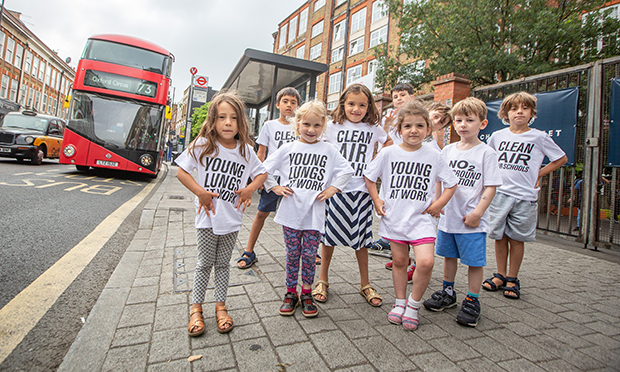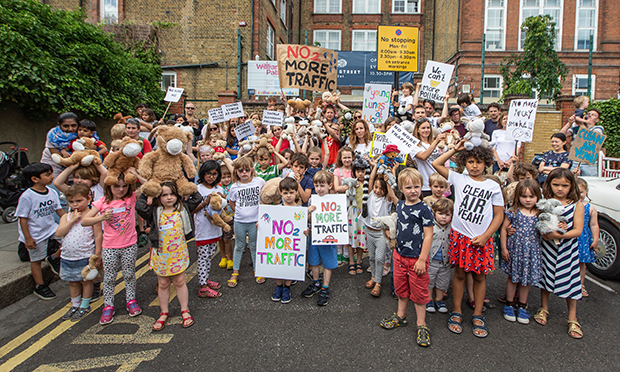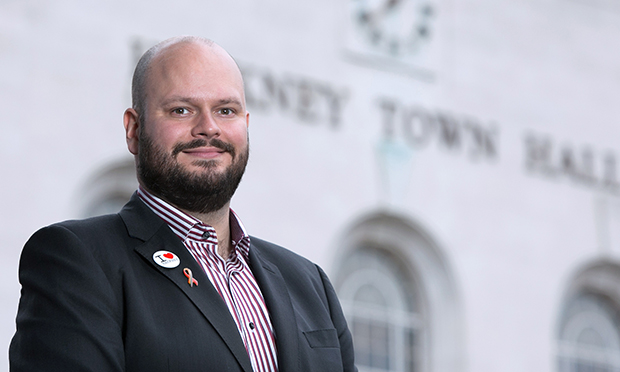Road closures: Boost for opponents as scientists reveal ‘toxic school run’ dangers

Getting shirty: William Patten pupils make a stand on Church Street. Photograph: Jamie Smith
Campaigners opposed to Hackney Council’s controversial road closure plans were bolstered today by new research which shows children are most at risk from toxic air when in and around school.
The Town Hall is set to decide next month whether to close up to four rat-runs in Stoke Newington, which could lead to a 21 per cent increase in traffic on nearby Church Street – home to schools that already suffer from illegal levels of air pollution.
The decision was delayed after responses to the initial consultation prompted the council to undertake further analysis of the scheme’s impacts on pollution and traffic.
The council recently admitted that its original traffic figures were wrong.
Now a new study has revealed that children in London take in 60 per cent of their daily air pollution during the school run or while at school.
The research, carried out by scientists at Queen Mary’s University on behalf of children’s charity Unicef, focused on black carbon – a pollutant that can penetrate deep into the lungs and enter the bloodstream.
It found that exposure to the particles is lowest when children are at home – even though they spend more time there.
Unicef has warned that peak periods of exposure damages the health of schoolchildren and the charity is calling on the government to protect children “where they are proven to be most at risk”.

Protest: parents and pupils marked Clean Air Day earlier this year. Photograph: Jamie Smith
Tom Knowles, a scientist and parent at William Patten primary, already one of London’s worst polluted schools, said: “Despite overwhelming evidence that children in Stoke Newington are breathing toxic air while at school, Hackney Council’s dangerous road closure plans threaten to remove traffic from streets which aren’t illegally polluted and displace it to streets which are – streets which are home to numerous schools and nurseries.”
The Clean Air 4 Schools campaign says a recent survey carried out at William Patten found that 96 per cent of families walk, scoot or cycle to the school.
Knowles added: “Learning that children typically breathe in more dirty air while they’re at school than at home should prompt councillors and officers to reduce traffic outside schools. They certainly shouldn’t be adding to it.
“We hope this research by highly-qualified and respected scientists will make Hackney Council rethink its Stoke Newington road closure plans, come up with a solution that works for the whole community and take bold and swift steps to reduce playground pollution.”
Amy Gibbs, Unicef UK’s Director of Advocacy, said: “Every day, thousands of children across the UK are setting off on a toxic school run that could impact their lifespan and contribute to serious long-term health problems.
“Parents already have numerous worries about health and safety risks to our children. The quality of air they breathe in the playground or as they walk to school should not be yet another burden.
“We cannot afford to continue to overlook this invisible but serious threat.”
Professor Jonathan Grigg, who led the Unicef-backed research, recently warned that extra traffic displaced past William Patten could put schoolchildren at greater risk of “suppressed lung growth, new onset asthma and, in younger children, pneumonia”.

Hackney Mayor Philip Glanville says the council is listening to parents’ ‘legitimate concerns’
Hackney Council disputes the findings of campaigners, as well as a recent Greater London Authority report, that dirty air levels at William Patten are already in breach of National Air Quality Objectives.
But it did concede that levels of nitrogen dioxide at nearby St Mary’s primary breach EU limits.
Speaking to the Citizen last week, Mayor Philip Glanville insisted the Town Hall is listening to parents’ concerns.
He said: “I think there are absolutely legitimate concerns from the school community, and I think we’ve been very clearly saying that we recognise those, and want to work with the school around the broader look of air quality there.
“I just do not accept the idea that we don’t care, or that we’re not listening, or that we don’t have any ideas about how to reduce air pollution at [William Patten] school.
“I don’t think it’s a zero-sum game. I think the people in that community that are saying that one thing will necessarily lead to another – as a politician, I don’t accept that.
“We’re still looking at the evidence base. They’ve got an evidence base, we’ve got some, the Greater London Authority (GLA) have others – all of that will go into the decision.”
A link to Unicef’s ‘Toxic School Run’ study can be found here
